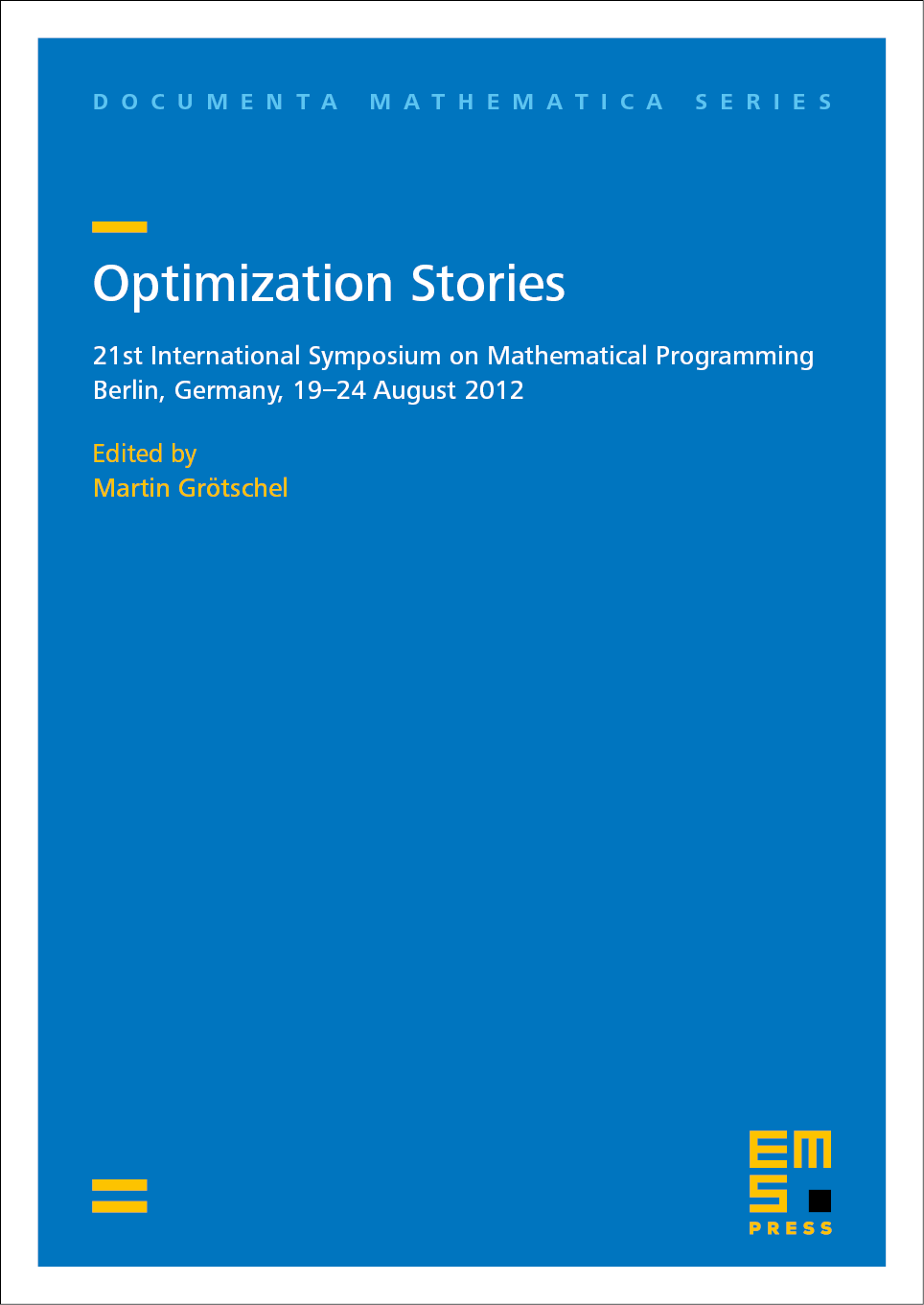Optimization Stories
21st International Symposium on Mathematical Programming. Berlin, Germany, 19–24 August 2012
Editors
Martin Grötschel
Konrad-Zuse-Zentrum für Informationstechnik Berlin (ZIB), Berlin, Germany

p. 460 Contentspp. 1–2 Prefacepp. 3–5 IntroductionMartin Grötschel
pp. 7–8 Stories about the old masters of optimizationMartin Grötschel
pp. 9–14 Jiu Zhang Suan Shu and the Gauss algorithm for linear equationsYa-Xiang Yuan
pp. 15–18 Leibniz and the brachistochroneEberhard Knobloch
pp. 19–23 Leibniz and the infiniteEberhard Knobloch
pp. 25–30 A short history of Newton's methodPeter Deuflhard
pp. 31–35 Euler and infinite speedEberhard Knobloch
pp. 37–42 Euler and variationsEberhard Knobloch
pp. 43–50 Euler, Mei-ko Kwan, Königsberg, and a Chinese postmanMartin GrötschelYa-Xiang Yuan
pp. 55–64 Who invented the interior-point method?David Shanno
pp. 65–73 Column generation for linear and integer programmingGeorge L. Nemhauser
pp. 75–85 Who solved the Hirsch conjecture?Günter M. Ziegler
pp. 87–93 Pope Gregory, the calendar, and continued fractionsFriedrich Eisenbrand
pp. 95–106 Löwner–John ellipsoidsMartin Henk
pp. 107–121 A brief history of linear and mixed-integer programming computationRobert E. Bixby
pp. 127–141 The origins of minimal spanning tree algorithms – Borůvka and JarníkHelena NesetrilováJaroslav Nesetril
pp. 143–153 The coming of the matroidsWilliam H. Cunningham
pp. 155–167 On the history of the shortest path problemAlexander Schrijver
pp. 169–180 On the history of the transportation and maximum flow problemsAlexander Schrijver
pp. 181–197 Edmonds, matching and the birth of polyhedral combinatoricsWilliam R. Pulleyblank
pp. 199–210 Flinders Petrie, the travelling salesman problem, and the beginning of mathematical modeling in archaeologyThomas L. GertzenMartin Grötschel
pp. 211–219 D. Ray Fulkerson and project schedulingRolf H. Möhring
pp. 221–226 The ongoing story of Gomory cutsGérard Cornuéjols
pp. 227–238 Markowitz and Manne + Eastman + Land and Doig = branch and boundWilliam Cook
pp. 239–245 Ronald Graham: laying the foundations of online optimizationSusanne Albers
pp. 251–254 Cauchy and the gradient methodClaude Lemaréchal
pp. 255–269 William Karush and the KKT theoremRichard W. Cottle
pp. 271–276 Nelder, Mead, and the other simplex methodMargaret H. Wright
pp. 277–290 Subgradient optimization in nonsmooth optimization (including the soviet revolution)Jean-Louis Goffin
pp. 291–300 A science fiction story in nonsmooth optimization originating at IIASARobert MifflinClaudia Sagastizábal
pp. 301–315 Broyden updating, the good and the bad!Andreas Griewank
pp. 317–329 Carathéodory on the road to the maximum principleHans Josef Pesch
pp. 331–343 The cold war and the maximum principle of optimal controlMichael PlailHans Josef Pesch
pp. 345–356 The princess and infinite-dimensional optimizationHans Josef Pesch
pp. 359–376 A brief history of NP-completeness, 1954–2012David S. Johnson
pp. 377–388 On the evolution of optimization modeling systemsRobert Fourer
pp. 389–400 Who invented the reverse mode of differentiation?Andreas Griewank
pp. 401–415 Gordon Moore and his law: numerical methods to the rescueRaúl Rojas
pp. 419–431 Voronoi diagrams and Delaunay triangulations: ubiquitous siamese twinsLionel PourninThomas M. Liebling
pp. 433–438 Around Hilbert’s 17th problemKonrad Schmüdgen
pp. 439–446 From Kepler to Hales, and back to HilbertMichael Joswig
pp. 447–453 Vilfredo Pareto and multi-objective optimizationMatthias Ehrgott
pp. 455–460 Optimisation and utility functionsWalter Schachermayer